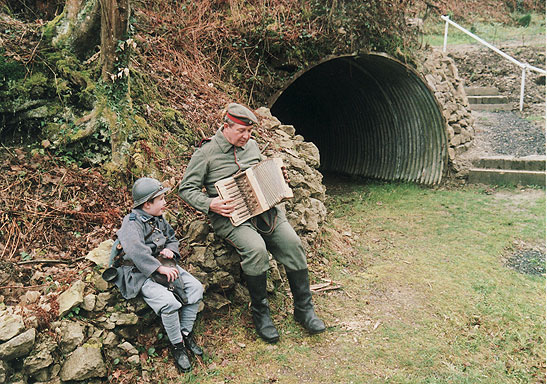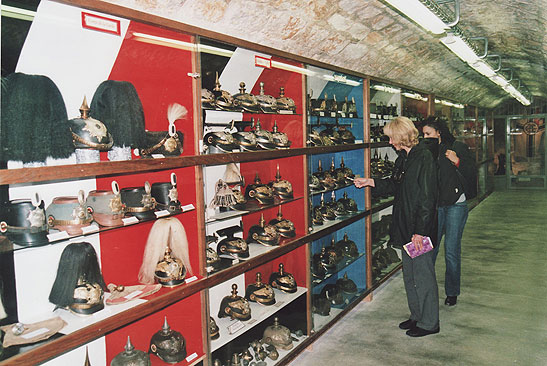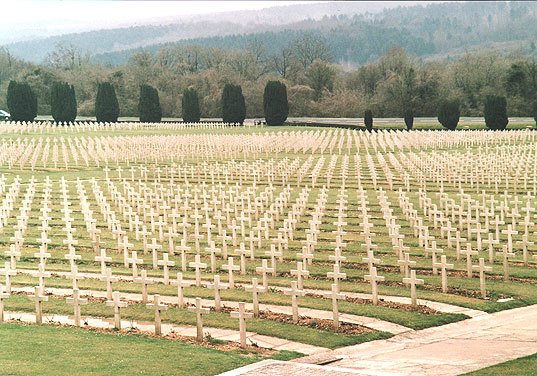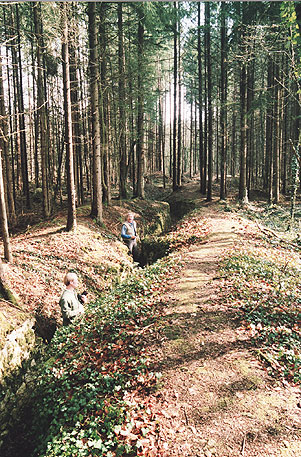|
The Lorraine Region
of France
Is Much More Fascinating Than Normandy Words and Pictures by John Clayton
OK, are you ready to put on your military WW1 boots, grab your unique WW1 steel helmet, put on your wartime imagination from those days, and join me as we explore a few of the memorable WW1 tourist attractions that should be on your next trip to France. It was a cold, drizzly sort of day --– the clouds were grey and menacing, and a light rain pitter pattered down all around me. As I looked up ahead, I was sure my eyes were deceiving me --– was that really a German soldier from World War One standing guard? Then again, maybe I was dreaming, and this was some sort of time warp? I moved much closer to what I’d seen --– it was a German soldier in a WW1 uniform trying (in a very clever way) to get the attention of tourists to see a unique attraction. I was near a village called Vienne Le Chateau, deep in the heart of the Argonne forest. The uniformed man was a Frenchman with the unlikely name of Serge Tourovsky, who helps give visitors a tour of Camp Moreau discovered in 1996, which is the result of a 10 year re-creation of a real German camp from WW1. It’s so realistic you expect a horde of German soldiers to come rushing out of their mountain side barracks at any moment. The camp illustrated how 600 soldiers lived --– where they showered, their mess hall, and trenches, some with old shells still waiting to be loaded into nearby canons.
History books tell you that much of WW1 was fought in trenches, and it’s hard to imagine how it was in those cramped, deep indentations in the ground, but The Marne Interpretive Center 14-18 www.marne14-18.fr has an exhibit that brilliantly re-creates trench warfare. You’re surrounded by sandbags, like a real 1914-1918 trench, and because of all the TV screens everywhere, you feel what it was like to fight and die in those deep ditches --– the rat-a-tat of the machine guns and the shouts of the soldiers going “over the top,” convince you this is the real thing. It’s the biggest fort in the area of Verdun, and is yet another reason why the Lorraine battlefield sites of WW1 are more interesting than Normandy. It’s the Citadelle Souterraine and once inside you’re treated to a fascinating 25 minute ride aboard a Disneyland type vehicle seating five people that gives you a mesmerizing trip around the fort --– it’s cold and dark for most of the journey, but you’ll be intrigued by the 15 tableaux depicting the life of a French infantryman, the fort’s bakery in action, the hospital, yes and even the trenches. Indeed, many of the things you see on this ride are so real you wonder how the actors in front of you manage to survive and keep warm in the bone chilling cold --– but you suddenly realize what you’re seeing are holograms. Tours, including English, are in six different languages.
Fort de la Pompelle is situated about 3 miles outside Reims, and is molded into the hillside. Inside there was a stunning array of military memorabilia --- from huge mortars to smaller guns and artillery pieces, including a collection of French 75 mm cannons, to uniforms and a vast array of military items --- from medals to lots of personal items, plus 560 of those classic looking German Wurttemberg steel helmets --– the ones with a large pointed spike on top, and surrounded with enough silver or golden adornments, to make even a King envious. Each helmet was in mint condition, and worth about $3,000 Although the Lorraine region is filled with an array of unique memorials and museums (all accessed through the local tourist offices) the most memorable is Fort de Douaumont in the Meuse region. Wandering around this forbidding fort, I clutched my coat even closer to my Nearby is the sad Douaumont Ossuary. (www.verdun-douaumont.com) This edifice, stark and visible for miles because of its 150 foot high tower, holds the unidentified remains of over 130,000 French and German soldiers that died in the Battle of Verdun – while that number is difficult to comprehend because of its size, it’s even more shocking to learn the monument is surrounded by a cemetery containing the remains of 15,000 identified French soldiers. If there is one stark fact that punches you in the belly and grabs your attention as it did mine, it’s that multitudes of cemeteries seem to appear on a never ending basis out of nowhere. You’re driving along a road with no building in sight and on the left hand side of the road, is a huge cemetery. Drive several miles and on the right, still more gravesites --– smaller, but a cemetery none the less. Verdun has 43 French cemeteries with 81,000 graves sites, 29 German with 55,000 grave sites, and two American ones with the identified remains of 18,000 bodies.
On my return to America, a friend asked what I’d found the most interesting. I said it was a virtually “untouched” and clearly visible German trench from WW1. What makes this even more, well bizarre is the only word that comes to mind, is that most tourists are not aware of its existence. We were driving through low lying, verdantly green fields that rolled off into infinity, when our mini bus slowed down, and turned right off the D907 road from Saint-Mihiel to Apremont-la-Foret. Now we were bumping along a rutted, overgrown weed track and, not more than about two hundred yards from the main road, our bus stopped. Over there, on the right hand side, we saw the moss covered concrete sides of what turned out to be several German trenches. Grass and weeds had overgrown just about everything, including a small sort of protruding column that had been a machine gun nest. Over there, to the right, the trench snaked through the forest in a zig zag fashion, and on out of our view. Although it was a lovely sunny day, my mind drifted back to 1917 when these trenches were filled with German soldiers fighting for their lives.
The smell of cordite wafted up my nostrils, and the whizzing sound of bullets and the loud staccato whine of machine guns, made me think I’d be killed any second. Then a voice said, “Over there, you’ll see one of the French trenches,” and I was suddenly brought back to reality, and lifted out of my war time reverie. Not more than 60 yards away, I could see the remains of French trenches – they were interesting, but were a re-creation, while the German ones were the real thing. If you’re in this area of Lorraine, do whatever you have to and find this place. It’s mesmerizing. Recommendations: For a vacation where you’ll (really) see something interesting and different, plan a trip to the Lorraine region of France. The best way to see everything is by contacting the local tourist boards, who’ll provide the names of reliable tour operators and guides. Although renting a car is an option, my advice is NOT to do that, as you’ll have no guide, and therefore find it difficult to locate the WW1 tourist related sites. All our guides were excellent, but I list only Florence Lamousse (Florence.lamousse@aliceadsl.fr) as she is a goldmine of intriguing information about many of the hidden WW1 attractions. There are a wonderful selection of gorgeous shops such as Gallerie
Lafayette in towns like Reims for women to “shop till they drop,”
but while some of the “Fair Sex” may be reluctant to do
a trip like this give it, as I did, a second look. It’s a fascinating
insight what Americans did in that forgotten war, and it’s a “vacation
experience” that in your recounting of what you saw, it’ll
intrigue your friends in the USA. Whether you’re a military aficionado,
or if you just want to sample the champagne and enjoy the beautiful
countryside and the many B&B’s and hotels that cover the region,
the Meuse Argonne area of the Lorraine region is a tourist delight.
www.lorrainetouriste.fr
and www.franceguide.com |




